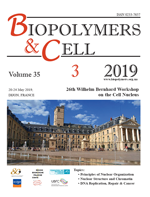High-resolution mapping of A/B compartments and topologically associated domains on giant lampbrush chromosomes
DOI:
https://doi.org/10.7124/bc.0009AFАнотація
Progress in studies aimed at “deciphering” the spatial architecture of the genome is determined by the development of several key technologies: the chromatin conformation capture, ultra-high resolution optical microscopy and genomic locus imaging. At the same time, it remains unclear how the domains, determined by chromatin conformation capture technology, including topologically associated domains (TADs) and A/B compartments, are correlated with the chromatin domains detected at the cytological level. In the framework of this problem, a comprehensive study of the chromatin domains of giant lampbrush chromosomes characteristic of the growing oocytes in birds, amphibians and reptiles, seems appropriate. Methods: Here we aimed at comparing the chromomeres – the main structural unit of lampbrush chromosome axes – and topologically associated domains and A/B compartments in domestic chicken (Gallus gallus domesticus), whose genome was the first among the deciphered avian genomes. In addition, earlier, using the full-genome Hi-C method a number of hierarchical structural domains, such as A and B compartments and TADs, were identified in chicken embryonic fibroblasts. Results: The results obtained allowed us to verify the hypothesis of the correspondence between the globular-loop chromatin domains of the interphase nucleus and the chromomere-loop complexes of lampbrush chromosomes, as well as to shed light on the nature of the lampbrush chromosome chromomeres. Funding: The research was supported by Russian Science Foundation (grant # 19-74-20075). The work was partially performed using equipment of the Research Resource Center ‘Molecular and cell technologies’ of SPbU.Завантаження
Опубліковано
2019-05-20
Номер
Розділ
Хроніка та інформація

